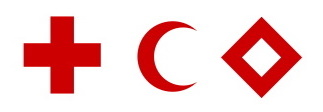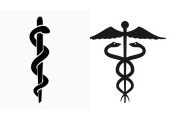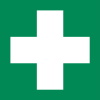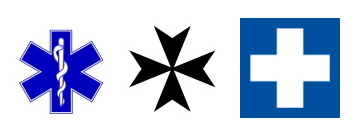In almost every workplace or public venue nowadays, you’ll see a symbol showing where to find a first aid kit or other first-aid facilities. But what if you’re in a non-English speaking country, and you can’t count on seeing the words “First Aid” written neatly underneath? Are the symbols for first aid the same in every country? And if not, what sign should you look out for if you’re looking for medical supplies or assistance in an emergency?
Let’s have a look at some of the world’s most well known and well established first aid signs.
The Red Cross (…and Crescent, and Crystal)

The first symbol that people associate with first aid signs is the Red Cross – the plain, square red cross on a white background. It’s almost universally recognised as a symbol for medicine and first aid. You see it in thousands of movies and computer games throughout the world – everything from MASH reruns, to James Bond films, to zombie apocalypse games. It’s also thoroughly illegal.
No, seriously. People aren’t supposed to be using that symbol. It’s not only trademarked – it’s protected by the Geneva Convention.
The Red Cross symbol dates from the very first Geneva Convention in 1864, where it was decided that countries in wartime should agree not to fire on medical facilities and transports – as denoted by the Red Cross symbol. The symbol was specifically reserved for military medical facilities, vehicles and personnel (particularly in wartime), and the actual Red Cross organisation (who effectively set up the Geneva Convention). It’s actually the Swiss flag with the colours reversed.
As such, although it’s become the most recognised medical symbol in the world, most of the places you see it in aren’t legal. And in recent years, the Red Cross has been cracking down on its use. They want to keep it reserved for its original purpose – keeping doctors and wounded personnel safe in wartime.
This has given rise to a lot of alternate medical symbols and first aid signs. Initially, many organisations simply reversed the colours to a white cross on a red background – but the problem is that this just turns the symbol into the Swiss flag – potentially causing confusion. So other alternatives are now seeing more use.
The red cross itself actually has two other versions of its symbol, which you might see in some countries. The Red Crescent was first used by the Ottoman Empire in the Russo-Turkish War of 1876-1878 as a Muslim equivalent of the Red Cross. The Ottomans thought the cross might alienate its Muslim soldiers. During the war, both sides agreed that the symbols were interchangeable. You may still see the Red Crescent symbol in Islamic countries. And in recent years, the “Red Crystal” (originally the “Red Diamond”) is increasingly used as a religion-neutral version of the Red Cross symbol in places like Israel.
Asclepius and Caduceus – a little history

Two medical symbols used nowadays are a lot older than the Geneva convention or even the Swiss flag. While not specifically first aid symbols, if you see them in a public place, they’ll often be marking something medical.
The Rod of Asclepius (that’s pronounced “az-KLEE-pee-us”, if you want to sound smart) is the symbol of a staff with a snake twisted around it. It comes from Greek mythology – Asclepius is the Greek god of medicine and healing. He carried a staff with a snake twined around it, which gave him knowledge and licked his ears clean (Greek mythology is like that). He was mentioned in the very first Hippocratic oath (the oath that doctors all take, promising to heal and not to harm), so his trademark staff is often used as a symbol for all things medical. It features in places like ambulance symbols and the flag of the World Health Organisation.
The symbol with TWO snakes coiled around a staff – sometimes a winged staff – is known as Caduceus (“ka-DOO-see-us”). It’s used widely as a medical symbol, and it’s… well… probably a mistake.
In Greek myth, Caduceus is the staff held by Hermes – messenger of the gods, and god of commerce, travellers, thieves and cunning. Its use as a medical symbol is largely because in 1902, the US Army Medical Department adopted the symbol as their symbol (at the recommendation of a single officer). Whether this was a deliberate choice or an accidental mix-up with the Rod of Asclepius is still debated today. But as a result, the twin-serpent staff – originally a symbol of commerce – has become a common medical symbol, particularly in America. Many people aren’t even aware the two symbols are different.
The Green Cross (the ISO standard)

The new worldwide standard for first aid signs is now the green cross – thanks to the ISO (the International Standards Organisation). This symbol uses the original Red Cross / Swiss Flag symbol, but makes it white on a green background (or vice versa). Green is the ISO colour for emergency and safety symbols (the emergency exit sign is one of the best-known examples).
You’ll also often see the white cross used on other ISO symbols, showing that something has a first aid or medical purpose. The symbols for an eyewash station or an automated defibrillator are two good examples. And the colour is now becoming the standard for all things first aid and medical – including many modern first aid kits and ambulance crew uniforms.
Other Common Symbols

There are a few other signs you’ll see in use for medical and first aid facilities around the world.
The Star of Life – the six-pointed blue star with the Rod of Asclepius logo inside – is now a standard medical symbol in America and many other countries and is often used on ambulances. Other regions (including Canada and parts of Africa and southern Asia) might use the Maltese Cross – the symbol of St John’s Ambulance.
And lastly, a white cross on a blue background is often used as a road sign to notify drivers that a hospital or other medical or first aid facility is ahead.
Keep an eye out for these medical and first aid signs, and even in a non-English speaking country, you’ll generally be on the right track for finding help when you need it.
Taking First Aid with you
Locating first aid facilities in a foreign country is one thing, but finding someone who can use a first aid kit is quite another. Fortunately, it’s pretty easy to bring those skills with you when you travel. First Aid Pro provides high-quality first aid training to both professionals and the general public at very affordable rates. Our one day course provides the training you’ll need to navigate a first aid kit and provide medical assistance to others in an emergency.
